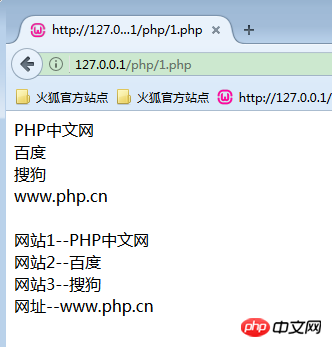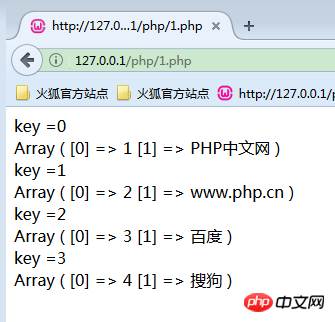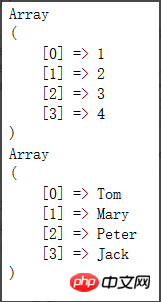 Backend Development
Backend Development
 PHP Tutorial
PHP Tutorial
 Detailed explanation of usage examples of foreach array traversal in PHP array (picture)
Detailed explanation of usage examples of foreach array traversal in PHP array (picture)
Detailed explanation of usage examples of foreach array traversal in PHP array (picture)
What is foreach to traverse an array?
When we use foreach to traverse an array, we often make mistakes due to unclear concepts. Here is a brief introduction to commonly used foreach operations.
(PHP 4, PHP 5, PHP 7)
The foreach syntax structure provides a simple way to traverse an array. foreach can only be applied to arrays and objects. If you try to apply it to variables of other data types, or uninitialized variables, an error message will be issued.
Two syntaxes for each foreach to traverse an array:
1 2 3 4 |
|
The first format traverses the given array_expression array. In each loop, the value of the current unit is assigned to $value and the pointer inside the array moves forward one step (so the next unit will be obtained in the next loop).
The second format does the same thing, except that the key name of the current unit will also be assigned to the variable $key in each loop.
Since PHP 5, it is also possible to traverse objects.
Note: When foreach starts executing, the pointer inside the array will automatically point to the first unit. This means there is no need to call reset() before the foreach loop.
Note: Unless the array is referenced, foreach operates on a copy of the specified array, not the array itself. foreach has some side effects on array pointers. Do not rely on the value of an array pointer during or after a foreach loop unless it is reset.
Since PHP 5, it is easy to modify the elements of an array by adding & before $value. This method assigns by reference rather than copying a value. The reference to
1 2 3 4 5 6 7 8 9 |
|
$value is only available if the array being traversed can be referenced (for example, it is a variable). The following code will not run:
1 2 3 4 5 |
|
Note: The $value reference of the last element of the array will still be retained after the foreach loop. It is recommended to use unset() to destroy it. foreach does not support the ability to suppress error messages using "@".
The following is an example of php foreach traversing an array
1. The array to be traversed is a one-dimensional array, which is relatively simple. If it is a single array, it is expressed in two ways, as follows:
1 2 3 4 5 6 7 8 9 10 11 |
|
The output result is:

2. If it is a one-dimensional associative array, it is displayed as follows, Note that the key values are different:
1 2 3 4 5 6 7 8 9 10 11 |
|
The traversal result is:

3. It is a little troublesome when traversing a two-dimensional array One point, the value at this time is an array, from which a variety of methods of operating arrays can be derived. Let’s traverse the basic two-dimensional array first:
1 2 3 4 5 6 7 8 9 10 11 12 13 |
|
The traversal results are as follows:

Use the second method. When traversing the array, pay attention to the key The value of , do not confuse it with the array id value;
1 2 3 4 5 6 7 8 9 10 11 12 13 14 |
|
The traversal results are as follows:

In addition, there are often requests to change a certain column of the two-dimensional array It becomes a one-dimensional array. At this time, the corresponding fields in value need to be taken out and placed in a one-dimensional array. If it is operated with a for loop, it is more cumbersome. It is simpler to use foreach. As follows, get the id column and name column of the current array. , stored in one-dimensional arrays respectively:
1 2 3 4 5 6 7 8 9 10 11 12 13 14 15 16 17 18 19 20 |
|
The traversal result is:

[Related tutorial recommendations]
1. Recommended related topics: "php array (Array)"
2. Recommended related video courses: " Use a foreach loop to traverse: index and associative array》
The above is the detailed content of Detailed explanation of usage examples of foreach array traversal in PHP array (picture). For more information, please follow other related articles on the PHP Chinese website!

Hot AI Tools

Undresser.AI Undress
AI-powered app for creating realistic nude photos

AI Clothes Remover
Online AI tool for removing clothes from photos.

Undress AI Tool
Undress images for free

Clothoff.io
AI clothes remover

Video Face Swap
Swap faces in any video effortlessly with our completely free AI face swap tool!

Hot Article

Hot Tools

Notepad++7.3.1
Easy-to-use and free code editor

SublimeText3 Chinese version
Chinese version, very easy to use

Zend Studio 13.0.1
Powerful PHP integrated development environment

Dreamweaver CS6
Visual web development tools

SublimeText3 Mac version
God-level code editing software (SublimeText3)

Hot Topics
 1677
1677
 14
14
 1431
1431
 52
52
 1334
1334
 25
25
 1280
1280
 29
29
 1257
1257
 24
24
 What happens if session_start() is called multiple times?
Apr 25, 2025 am 12:06 AM
What happens if session_start() is called multiple times?
Apr 25, 2025 am 12:06 AM
Multiple calls to session_start() will result in warning messages and possible data overwrites. 1) PHP will issue a warning, prompting that the session has been started. 2) It may cause unexpected overwriting of session data. 3) Use session_status() to check the session status to avoid repeated calls.
 The Compatibility of IIS and PHP: A Deep Dive
Apr 22, 2025 am 12:01 AM
The Compatibility of IIS and PHP: A Deep Dive
Apr 22, 2025 am 12:01 AM
IIS and PHP are compatible and are implemented through FastCGI. 1.IIS forwards the .php file request to the FastCGI module through the configuration file. 2. The FastCGI module starts the PHP process to process requests to improve performance and stability. 3. In actual applications, you need to pay attention to configuration details, error debugging and performance optimization.
 What is the significance of the session_start() function?
May 03, 2025 am 12:18 AM
What is the significance of the session_start() function?
May 03, 2025 am 12:18 AM
session_start()iscrucialinPHPformanagingusersessions.1)Itinitiatesanewsessionifnoneexists,2)resumesanexistingsession,and3)setsasessioncookieforcontinuityacrossrequests,enablingapplicationslikeuserauthenticationandpersonalizedcontent.
 Composer: Aiding PHP Development Through AI
Apr 29, 2025 am 12:27 AM
Composer: Aiding PHP Development Through AI
Apr 29, 2025 am 12:27 AM
AI can help optimize the use of Composer. Specific methods include: 1. Dependency management optimization: AI analyzes dependencies, recommends the best version combination, and reduces conflicts. 2. Automated code generation: AI generates composer.json files that conform to best practices. 3. Improve code quality: AI detects potential problems, provides optimization suggestions, and improves code quality. These methods are implemented through machine learning and natural language processing technologies to help developers improve efficiency and code quality.
 PHP and IIS: Making Them Work Together
Apr 21, 2025 am 12:06 AM
PHP and IIS: Making Them Work Together
Apr 21, 2025 am 12:06 AM
Configuring and running PHP on IIS requires the following steps: 1) Download and install PHP, 2) Configuring IIS and adding FastCGI module, 3) Create and set up an application pool, 4) Create a website and bind to an application pool. Through these steps, you can easily deploy PHP applications on your Windows server and improve application stability and efficiency by configuring scaling and optimizing performance.
 H5: Key Improvements in HTML5
Apr 28, 2025 am 12:26 AM
H5: Key Improvements in HTML5
Apr 28, 2025 am 12:26 AM
HTML5 brings five key improvements: 1. Semantic tags improve code clarity and SEO effects; 2. Multimedia support simplifies video and audio embedding; 3. Form enhancement simplifies verification; 4. Offline and local storage improves user experience; 5. Canvas and graphics functions enhance the visualization of web pages.
 How to use MySQL functions for data processing and calculation
Apr 29, 2025 pm 04:21 PM
How to use MySQL functions for data processing and calculation
Apr 29, 2025 pm 04:21 PM
MySQL functions can be used for data processing and calculation. 1. Basic usage includes string processing, date calculation and mathematical operations. 2. Advanced usage involves combining multiple functions to implement complex operations. 3. Performance optimization requires avoiding the use of functions in the WHERE clause and using GROUPBY and temporary tables.
 Composer: The Package Manager for PHP Developers
May 02, 2025 am 12:23 AM
Composer: The Package Manager for PHP Developers
May 02, 2025 am 12:23 AM
Composer is a dependency management tool for PHP, and manages project dependencies through composer.json file. 1) parse composer.json to obtain dependency information; 2) parse dependencies to form a dependency tree; 3) download and install dependencies from Packagist to the vendor directory; 4) generate composer.lock file to lock the dependency version to ensure team consistency and project maintainability.



